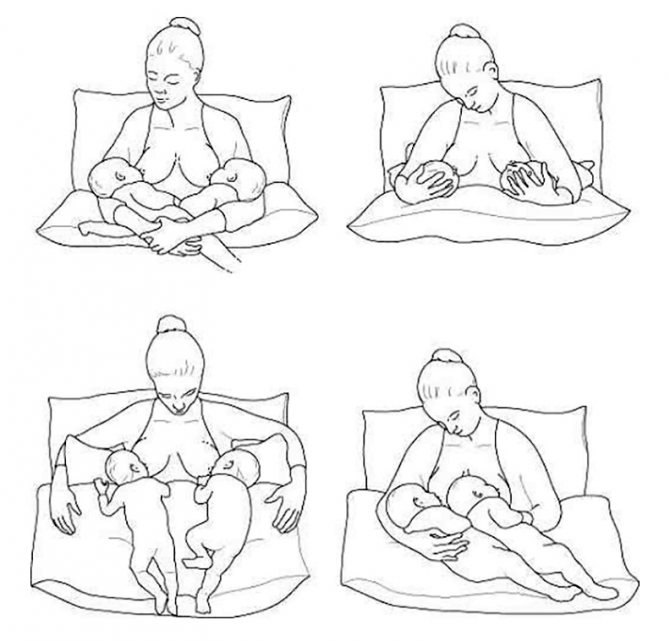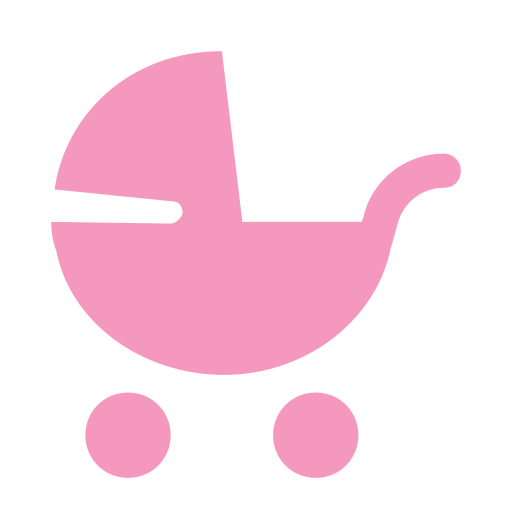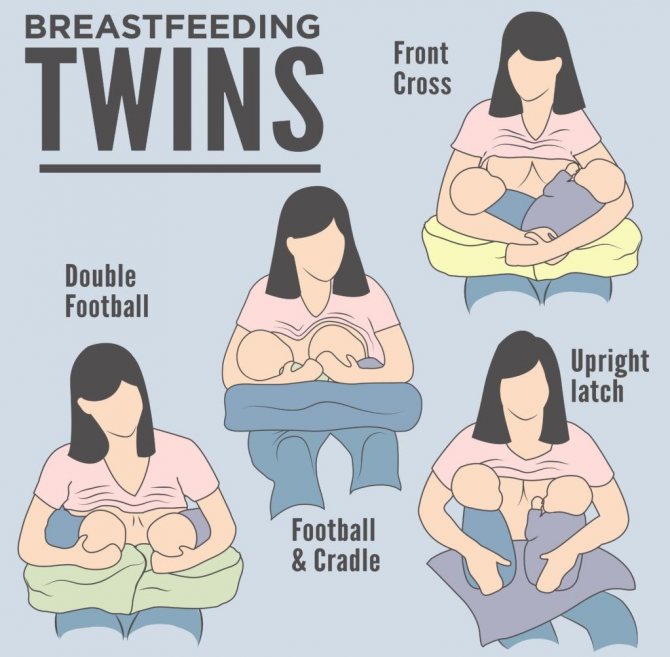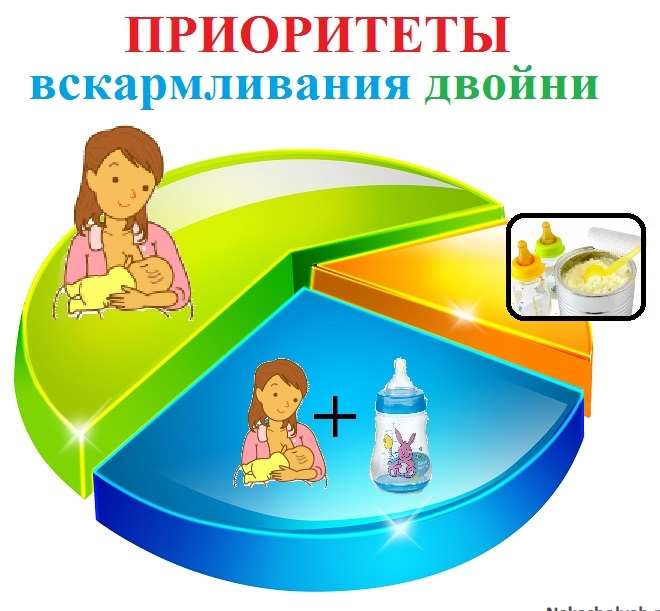The leaflet can be downloaded from this link
TwinsHandout
Finding out that you are pregnant with twins may have changed many of your expectations, plans and decisions. However, your decision to breastfeed can stand! Breast milk is especially important for twins as they are often born small and need all its benefits. Additionally, breastfeeding helps mom create a special and much-needed bond with both children. Many mothers have done a great job breastfeeding their twins. You too can enjoy this special bonding time with your little ones.
Simultaneously or one by one?
My answer is simultaneously. Well, unless, of course, you feel sorry for yourself and you don’t have help with everyday life.
At first, getting used to the role of a mother, I tried to feed the children in turns. As a result, the feeding process turned into one continuous meal - from morning to evening and from night to morning, without my full sleep and rest.
As a result, milk began to disappear due to constant lack of sleep...
I had to introduce a regimen and organize simultaneous feeding.
Where to begin?
The best way to start breastfeeding is to start feeding as early as possible and feed often. Even if your health does not yet allow you to be together, this does not mean that you will have to give up breastfeeding. In this case, the best way to establish breastfeeding is to express milk frequently, starting as early as possible. If you have to express milk because one or both babies are not yet able to breastfeed effectively, it is best to express colostrum by hand. If the need to express continues, rent a clinical electric breast pump that allows you to express from both breasts at the same time. Pump at least 8 times a day - every 2-3 hours during the day and at least once at night. Breast milk production is regulated by the emptying of the breast (during sucking or pumping). Emptying your breasts frequently and thoroughly increases milk production. That's why most twin moms have enough milk to breastfeed both babies.
On demand or by hour (routine)?
Only according to the regime. The reasons are the same: if you feed on demand, you will only do this, and there will be no time left for sleep.
I fed one, the other wanted it. While this one finishes eating, the first one gets hungry again - and so on endlessly...
For the first three months, pediatricians recommended that I feed them every three hours (they were gaining weight poorly), then with each month one night feeding was removed. By six months they ate at night at 12 o'clock and slept until 9 am - it was just some kind of holiday))
Main problems
A mother nursing twins faces identical problems as a nursing mother of a single baby:
- cracks and inflammation in the nipples due to high stress during sucking;
- lactostasis due to stagnation of not completely sucked milk;
- lack of milk volumes for babies.
And if the first two problems are quite easy to cope with with the help of healing creams and the use of a breast pump, then the latter requires special attention.
In principle, if a woman has managed to carry twins, then her body is already “programmed” to produce a double volume of milk, she can only direct all her strength to pumping her breasts. Achieving the goal is quite simple: you need to put both babies to the breast more often, because the more they drink, the greater the volume of lactation will be.
But the establishment of lactation can take quite a long period, in addition, disturbances in sleep patterns, nutrition, as well as stress that inevitably arises when caring for infants can affect the volume of milk in the mother, which may not be enough to saturate both children.
From 0 to six months
The most important and most difficult stage. It is very important to continue breastfeeding during this time, especially if your babies were born prematurely. Therefore, mom has to adapt in every way.
How to breastfeed twins?
The undoubted advantages of breastfeeding:
- Great benefit for the formation of children's immunity;
- There is no special hassle in preparing food - it is always with you, fresh and at the right temperature.
However, often in the maternity hospital, premature newborn twins are not allowed to be put to the breast due to a depressed sucking reflex, general weakness and other reasons.
It is important to purchase a good breast pump, the use of which will not allow your milk to disappear at the earliest stages.
Electric (left) and manual (right) breast pumps
I expressed according to this plan:
- Before the procedure, I drank a glass of hot tea with milk (or lactation tea);
- I pumped one breast for 15 minutes, then the second, and then again the first and second in turn - 5 minutes each.
- I repeated all this every three hours (that is, before each feeding).
Some doctors advise expressing one breast at a time at each feeding. However, with this approach I had severe lactostasis.
Then the children were allowed to be put to the breast and fed that way. But my guys, having gotten used to the bottle, were lazy to suck, did not latch onto the breast correctly, and it hurt me. Plus, I couldn’t feed them together, because I was always alone and it was simply unrealistic to hold both of them. And I couldn’t sit for another 2 weeks because of the stitches after the episiotomy. Therefore, I decided to stop breastfeeding using a breast pump. My patience lasted for 6 months.
Poses
In the postpartum period, I tried to put children to the breast one at a time.
To do this I used the following poses:
- Cradle. The baby lies on the mother’s left or right hand, as if in a cradle (his head rests on the mother’s elbow) and sucks on the same breast, respectively (left or right). Here it is important to provide support for your elbow - place it on the side back of a sofa or chair, or on a bolster made of pillows or blankets.
- Position next to mom (from under the arm). The child lies on the side of the mother, his legs behind her back. The baby's head lies on the mother's palm.
- Lying on your side. The child lies in front of the mother, and the mother lies on either side.
They look like this:
[Show slideshow]
All of them were comfortable for me personally, but still the children could not properly grasp the breast and pull something out of it. It was a little easier when using silicone pads.
In addition, there are special positions for feeding twins:

Unfortunately, it didn’t work out for me with them.
Many mothers of twins praise special devices - pillows for feeding twins. They allow the mother to hold both babies on the pillow on opposite sides of her and feed them at the same time.
They look like this:

Twin nursing pillows
I don’t know how such mega-moms do it. But I tried to position the children in the same way, only on separate pillows - they rolled, spun, slid downside down and immediately vomited everything they had eaten like a fountain... Or I myself had to sit next to them in the “Zu” position. Apparently I did something wrong.
And even if you manage to apply them like this in the first three months, in the future, when the babies learn to roll over and explore the world, it will be very difficult to keep them in this position.
But in any case, everything is individual. Who knows, maybe such a pillow will make your life easier)
But I decided to go a different way.

You might be interested to know
When will it get easier with twins? You can learn about this from our article.
How is parental leave arranged for twins? Information is here.
Mixed feeding
My children were fed this way.
Even in the maternity hospital, in the first days I was not allowed to put them to my breast due to prematurity and related problems. At first there was little milk, so formula was the basis, and we supplemented with expressed breast milk. At one month they switched to full breastfeeding (they still pumped, they didn’t breastfeed), but they didn’t gain weight well on milk and were always hungry. I had to reintroduce the mixture at 3 months and immediately began to sleep peacefully.
As I already said, at first I fed in turns.
But after a few days of such “work” it became physically unrealistically difficult for me:
- You pump for thirty to forty minutes.
- You feed with formula, then with expressed milk, first for one (half an hour), then for the other.
- Sterilize bottles.
- You sleep for an hour, soothe the baby’s colic, change diapers, or do something else during this time (if you’re very lucky).
- Doing the same thing again. Every day. For days.
- You are slowly going crazy without sleep and rest.
After that, I decided to learn how to feed my twins with both formula and expressed milk.
For this:
- took one large pillow or two small ones;
- I laid the children on them at an angle (legs down, head up, so as not to regurgitate what they had eaten);
- sat facing a pillow or between two pillows;
- took bottles in both hands;
- I gave expressed milk first, and then the formula to both at the same time (that is, we had 2 pairs of different bottles).
This approach saved a lot of my time - everything took no more than an hour.
After feeding, the children often fell asleep, so the remaining two hours could be spent at their own discretion.
Artificial feeding
The feeding procedure is no different from mixed feeding, except that you don’t need to express your milk, which means you save about another half hour to an hour of your time.
But keep in mind that:
- Children, of course, will grow up purely on formula, but they will not receive the full amount of useful substances and your antibodies. Therefore, if you have the opportunity to supplement your milk (whether breastfeeding or expressed milk - it’s not so important) - be sure to take advantage of it.
- Formula feeding with twins is quite expensive. As a rule, a jar of formula lasts for a day (with mixed feeding, we had enough for 1.5 days). In addition, when using the mixture, you have to run around with bottles, look for ways to sterilize them, and boil/cool the water every three hours day and night.
Overall, it's still a pleasure.
Organization of the feeding process
Since breastfeeding twins puts a significant strain on the female body, you should get enough sleep (let your husband help with this), eat a balanced diet, and have the right psychological attitude.

You will need helpers, because overwork and stress reduce milk synthesis. Emotional stress blocks the production of oxytocin, the pleasure hormone that is involved in milk production.
To stimulate milk production and let-in, babies should breastfeed as often as possible.
In the first weeks, feed infants on demand, apply them to the breast when smacking, turning the head, or sucking fingers (every half hour) appears. Then switch to feeding according to the schedule - this will help organize your daily routine and make your life easier.
It is recommended to drink plenty of water throughout the day - warm water, tea, milk.
What's the best way to feed twins?
Many mothers are interested in how best to breastfeed twins: one at a time or at the same time.
It is impossible to answer unequivocally, since each option has its own disadvantages. Alternate feeding turns into endless feeding, children demand the breast every hour, and “hang” on it for a long time. This leads to the threat of a nervous breakdown, because you will have no free time at all.
In this regard, feeding twins at the same time is more profitable: you immediately feed both of them and put them to bed (this is the ideal option). But it will not be easy for you to hold both babies and monitor the amount you eat.
Pediatricians do not recommend assigning each child a specific breast - change breasts regularly and place the child on different breasts.
This is explained by the unequal volume of milk produced; as a result, one baby may not get enough to eat.
In addition, constant localization in one breast can cause asymmetry in the development of some organs of the baby (head, eyes).
From six months and older
Everything is much simpler here. Children happily hold bottles and put them in their mouths (sometimes they choke, of course, but who has it easy in learning?), and complementary feeding begins to save them from the constant milk cycle.
You need to feed them pureed dishes according to the same scheme as with the mixture - at the same time:
- Place a plate or jar with a spoon on each table;
- You take the spoons in both hands;
- At the same time, you put food in their mouths, simultaneously developing your coordination. By the way, it’s very useful for mom)))
For convenience, we bought two transformable high chairs with the ability to recline feeding (at six months the children were not yet sitting). The table could be removed and reinstalled.
We finished eating like this by about a year. Then the children were taught to use spoons and sippy cups themselves, and at 1.5 years I removed the formula. It became much easier)
You might be interested to know
What benefits for the birth of twins are provided at the state level?
How is a lump sum payment paid for the birth of twins? Find out here.
Read about the features of raising twins here.
Convenient positions
Even before the babies are born, you should familiarize yourself with the positions for feeding twins. At home, grandparents and spouses can help. In the maternity hospital you will have to cope with difficulties on your own.
- Hand feeding. Sit on a hard surface, place pillows on both sides near your hips. Place the baby's head on each palm so that his body extends out from under the hand.
- Crisscross. Sit on the bed, put one baby on your legs, pressing his stomach to yours. Place the other child in the same way in the opposite direction, pressing his tummy to the back of the twin.
- Double cradle. Sit in a chair and take one child in the usual manner in the “cradle” position. Place the second baby in the same way, but on the other hand.
At first, it will be difficult to adapt to simultaneous breastfeeding, but soon the new mother will learn to easily cope without outside help.

FAQ
Many mothers are interested - I answer.
Will there be enough milk for two?
It should be enough. Only for this you need to express both breasts each time.
As the doctor explained to me, the more you express and work with your breasts (put your baby to your breast for feeding), the more milk you will have.
I confirm that this is exactly the case. The only thing is, I still didn’t understand why my milk was “blue” without rich sour cream on top, and the children didn’t get enough of it, although it was more than enough in volume.
If you have a lot of milk, you can freeze it and, if necessary, leave it for relatives to feed when you are not at home at this time.
How can you tell if babies have enough milk?
It can be determined by the following factors:
- Children are calm, they sleep well and do not scream after each feeding.
- Babies gain weight well (from 300 grams per month).
- Children poop and pee a lot every day (you change diapers often).
If there is not enough milk, it makes sense to contact a pediatrician, a lactation consultant, or introduce formula supplementation.
Benefits of breastfeeding
Breast milk is the ideal nutrition for all babies without exception. This natural nutrition will be especially useful for twins, because, as a rule, such babies are born with not very much weight. To catch up with their “peers”, infants need the best and most nutritious - mother's milk. No mixture can compare with a natural lactation product created specifically for babies.
Don’t be afraid that you won’t have enough milk to feed both babies - nature has provided everything, and with proper lactation, nutrition and regimen, you can successfully cope with breastfeeding twins. By organizing it, you will immediately achieve several positive goals.
- Babies will receive better nutrition, providing them with all the substances necessary for growth and development.
- Lacto- and bifidobacteria contained in breast milk will populate the intestines of twins with natural microflora, which will speed up the establishment of digestive processes in babies.
- With the help of her milk, a nursing mother will pass on antibodies to her children against the disease, which will make their immune system stronger.
- The bodily contact that occurs with the mother while suckling the breast will have a positive effect on both the health of the babies and their psyche.
- Producing a double “portion” of milk will require quite a lot of energy, so the nursing mother will quickly return to ideal shape after pregnancy.
- Breastfeeding is not only extremely beneficial for children, but also significantly saves the family budget, which is important for parents of twins, who will now have to buy all things in duplicate.
Nutrition for a nursing mother of several children
And just for a nursing mother, and especially for mothers of twins and triplets, it is absolutely not worth following the recommendations to adhere to a strict diet.
A woman should eat in her usual way, tracking the individual reaction of a particular child (changes in behavior, stool, regurgitation, rashes). If the child has a reaction, then the product is excluded and, conversely, if there is no reaction, the product is present in the diet.
For a nursing mother, the diet should contain enough of all the necessary substances. However, it is worth remembering that a child is likely to have an allergic reaction to some foods and in this case it is better to exclude it for a while.
If the expectant woman collects all the necessary information and prepares in advance, then there should be no difficulties in feeding two babies.
Any mother needs to pay attention to good attachment, frequent sucking and, of course, she really needs helpers. You need to know where to turn for help if something doesn’t work out, typical problems arise: it hurts to feed, there are difficulties with the amount of milk. You need to contact natural feeding consultants; they are competent and can provide assistance. Don’t be patient and don’t think that difficulties will go away on their own.
If you liked the article, please share a link to it
Tandem feeding
When a woman feeds both an older and a younger child, her body adjusts to “twin mode.” The mother feeds the youngest one first until he is completely full, and only then feeds the older one. The misconception in this case is the distribution of the mother —
“each breast for its own child.” A woman’s breast is a paired organ, so there is no need to resort to this distribution. It is imperative to resort to organizing the nutrition and behavior of the older child during feeding, so that in the future, when feeding two children, inconvenient and uncomfortable situations do not arise.
Mixed feeding of twins - how to organize it
The main mistake of many parents is the inability to correctly organize the process

mixed feeding of twins. This means the following: the child ate his mother’s milk, and it seemed to the mother that he was not full. What to do in this case? That's right - dilute the mixture. And feed him so that he falls asleep peacefully.
I know this “disease”; we ourselves went through it due to our inexperienced stupidity. And what happens in the end? Mother's milk and formula, no matter how good it is, have completely different compositions. And so two different products enter the stomach of the child, who is not yet fully strengthened, and mix there with each other. What will be the reaction? That's right, your stomach will hurt and colic will begin. They will begin anyway, because the baby’s gastrointestinal tract will begin to function normally only 2–3 months after birth. But with food of different composition, everything will be much more difficult.
Therefore, in order to avoid unnecessary hassle and not spoil the lives of yourself and your children, you need to allocate a separate feeding for mixed feeding of twins and adjust the daily routine for twins to it. For example: in the morning the babies ate breastfeeding. And at the next feeding - a bottle. Then again the chest. And so on alternating. By skipping one feeding, more milk will be collected, the babies actively eat it - and the more you eat, the more will come.
Mixed feeding of twins - summing up
No matter what anyone tells you about

mixed feeding of twins, no matter how the feeding and life of the babies are organized immediately after birth in the maternity hospital, the most important task in the first months is to establish breastfeeding. And only after all options have been tried, move on to mixed feeding of twins and the use of formulas.
Putting children on formula today is not such a problem. They will suck the bottle with pleasure, but then returning back to the breast will be problematic. And the later you introduce the mixture into your children’s diet, the better it will be for everyone.
If you can do without the mixture at all, great. Complementary feeding will begin at 6 months, and there will be a completely different picture. Well, if you still can’t do without formula, then switch to mixed feeding for twins, it is better than just artificial.
If separation in the maternity hospital
Another nuance in the case of twins, when a woman gives birth prematurely or one of the babies is weaker, the mother and children can be separated in the maternity hospital. In this case, it is necessary to resort to pumping and this must be done no later than six hours after birth. The importance is that in the future the flow of milk will not be painful. You need to make your chest work.
At this stage there is practically no milk, there is colostrum in small quantities, so it is not always comfortable to use a breast pump or resort to manual expression techniques. If a woman continues to be without her baby nearby, she needs to pump every two hours for 10 minutes on each breast. If it is possible to collect colostrum and store it, after reunification with the babies, the product can be used in future feedings. For example, collect colostrum in a syringe and freeze it.
Colostrum is a very valuable liquid and contains many immune factors.
You can exclude the use of colostrum only if you are given drugs that are incompatible with breastfeeding. You need to contact a breastfeeding consultant and clarify information about the effect of the elements of the drug on the child.










